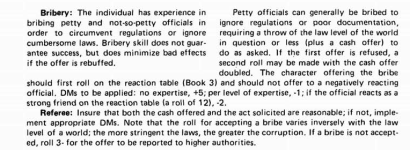Enoki
SOC-14 1K
There's no current method or statistic I know of that gives just how dangerous a system or region of the Imperium or beyond it really is. I think it might be both interesting and useful if there were. After all, for many Traveller adventures the players are going into the dangerous parts of space.
If there were some general estimate of how dangerous--be it war, crime, violence, or whatever in general--that some system or region of space were it would be useful not just from a warning standpoint, but from one of designing scenarios.
This part of space is known to be incredibly dangerous. Are you sure you really want to go there?
What would a measure of this be? What variables are involved?
If there were some general estimate of how dangerous--be it war, crime, violence, or whatever in general--that some system or region of space were it would be useful not just from a warning standpoint, but from one of designing scenarios.
This part of space is known to be incredibly dangerous. Are you sure you really want to go there?
What would a measure of this be? What variables are involved?

